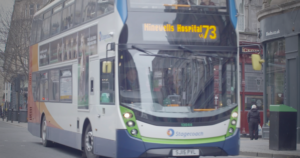
Mark Ross
Mark is an undergraduate student of Politics and French at the University of Bristol. Born and raised in Edinburgh, he has a keen interest in local government and public policy in Scotland.
Electric vehicles are central to Scotland’s climate goals, but to achieve them our charging network urgently needs a jump start
Electric Vehicles are vitally important to Scotland’s climate change plans, not least to phase out new petrol and diesel cars by 2030. Yet with less than 8 years to go, there are nowhere near enough charging points in Scotland. More than this, the ones that do exist are distributed unevenly, risking regional inequality. To accelerate our transition to electric cars, and to ensure that charging is available to all Scots, this article argues that charging points should be organised regionally.
Surface transport causes 19% of Scotland’s carbon emissions, of which 57% comes from cars. Therefore, the biggest climate wins lie in kicking Scotland’s polluting car habit. This is where electric vehicles come in. To encourage Scots to go electric, we need to provide more charging points, and in a fairer way, not least because households claim that one of the main disincentives to buying electric vehicles is a lack of access to charging points. Although Scotland has impressed with its charging infrastructure so far, it needs to grow its network whilst ensuring that it covers the whole of Scotland, not just cities. This is especially important in avoiding charging ‘blackspots’, such as the one I will go on to describe in Strathclyde.
The government’s climate targets are ambitious but we have not yet seen the action required to meet them. Goals such as ‘halving transport emissions from 2019 to 2025’ and ‘reducing car kilometres driven by 20%’, are ‘extremely stretching’, according to the Committee on Climate Change (the CCC) – the independent body which review government proposals. This is especially true given that carbon emissions from transport have remained stagnant in Scotland over the last decade – as my last report for Our Scottish Future showed. If we are to reach these goals, we need to develop a more comprehensive charging network to encourage Scots to go electric.
Scots are willing to change, but cannot do so without government action
There are 47 charging devices in Scotland per 100,000 people, compared with an average of 36 for the rest of the UK, an impressive achievement. Unfortunately, according to the government’s own analysis, this is still not good enough.
The CCC implies that, to meet government targets, 4000 new chargers could be required annually. The Scottish Government has calculated that this would require investment approaching ‘£100m’ per year excluding operational costs. This may sound significant, but it is a fraction of the £4bn the government spent on roadbuilding from 2011-2021. Instead, the government invested only £45m in the ‘ChargePlace’ network in the entire time between 2013 and 2021. A funding shortfall does not inspire confidence in drivers thinking of switching to EV’s.
How could we fix EV charging?
Currently, local councils find, buy and operate EV charge points. The main funding source is the Local Authority Investment Programme, under which councils receive 100% capital grants towards the installation of charge points. The current system, combined with the increasing demand for EV’s has created several problems.
Firstly, there are areas with extremely limited charging infrastructure. The four councils with the fewest ChargePlace charging points are East Dunbartonshire (15.6 charging points per 100,000 residents), West Dunbartonshire (20.3), East Renfrewshire (10.4) and Inverclyde (28.5). These are extremely low rates of coverage, at around or below 50% of the Scottish average of charging points per 100,000 people. It pales even further behind the front-running regions, such as the 83 for every 100,000 achieved at London’s regional scale by its mayor.
And the impact of this? Hard pressed drivers in the fringe around Scotland’s largest city are being deterred from switching to electric cars. Whilst some of the housing outside our city centres will be able to support home charging, such as driveways, these forms of private off-street parking cannot fully replace a public charging network. (Not least because people often need to fuel their car when travelling, not just when parked at home. That’s half the point of petrol stations.)
Equality is put at risk if charging point ‘blackspots’ and underinvestment in a publicly-owned baseline network create knock-on difficulties. Limited access to public charge points means that driveway-owners disproportionately benefit from other policies incentivising electric vehicle uptake, such as subsidies for purchasing EV’s. This undermines the ‘just transition’ we are all aiming for.
Secondly, different councils charge different prices for charging electric vehicles. In two thirds of councils, it is free to charge an EV. As EV’s become more popular, this risks distorting consumer behaviour. Drivers may save money by charging their vehicle in a neighbouring council area, encouraging them to waste energy travelling to distant charging points. This could cause spikes in demand in the more affordable councils, and a self-defeating drop in use in others.
Thirdly, as EV demand increases, so will the burden on councils. This means that EV users will be benefitting from council spending, when those using public transport will still have to pay their fares themselves. The principle that public transport users still have to pay, when car journeys are subsidised, is counter-intuitive, given that incentivising public transport use is a key way to reduce carbon emissions.
Think Regionally, Act Locally
To jumpstart Scotland’s charging network, the government should adopt these principles:
- Boosting our regions’ capacity to organise the charging network and to distribute funding. We already have bodies of the right scale, the ‘Regional Transport Partnerships’ (RTPs) covering each part of Scotland, of which the most well-known is the Strathclyde Partnership for Transport (STP) that runs Glasgow’s subway. They should be empowered to even up car charging at their regional scale. Local authorities, however, should still decide the final location and run the installation. This includes bundling the integration of charging points with other maintenance or infrastructure programmes to minimise disruption. This combination would improve, firstly, the problem of poor coverage. Regional organisation would ensure fair and widespread access to charging points. Councils working individually may neglect certain regions through over or under provision in certain areas (i.e. those with high population densities). Higher-level planning would guarantee an equal regional distribution of chargers; the scale at which people live the main part of their day to day lives. For example, the councils mentioned earlier sit within one RTP – the Strathclyde Partnerships for Transport (STP). Had the network been organised by the STP, this ‘blackspot’ could have been noticed and corrected.
- Remove the incentive to drive for cheaper charging by using an integrated regional approach to standardise pricing. Pricing differences across councils would be remedied by such an approach, as RTPs would have the scope to iron out regional differences. Whilst some inter-RTP communication may be required to address differences across RTP borders, the scale of regional organisation would address the bulk of the distorted behaviour caused by local councils having different charging prices.
Cooperation is key to empowering existing institutions
The government has made ‘enabling local authorities’ to ‘plan public EV charging infrastructure’ a priority. But this commitment lacks the level of concrete planning required to implement it. If we want to move quickly towards our ambitious climate goals, the government should empower existing institutions to jump start Scotland’s charging network.





